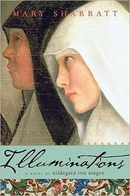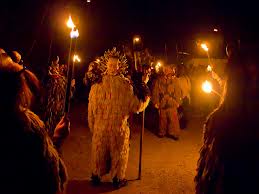 Mary Sharratt is the author of the critically acclaimed novels SUMMIT AVENUE, THE REAL MINERVA, THE VANISHING POINT and DAUGHTERS OF THE WITCHING HILL. Her latest work of fiction, ILLUMINATIONS: A Novel of Hildegard von Bingen, released in October. In 2002, Mary moved from the sunny San Francisco Bay Area to Lancashire in northern England, where, in December, it was pitch black by 4pm. She explains how reading Susan Cooper’s young adult novel, THE DARK IS RISING, helped her put her own struggle with the midwinter darkness in perspective, seeing it as part of a deeper and eternal Story while illuminating the true meaning of the season.
Mary Sharratt is the author of the critically acclaimed novels SUMMIT AVENUE, THE REAL MINERVA, THE VANISHING POINT and DAUGHTERS OF THE WITCHING HILL. Her latest work of fiction, ILLUMINATIONS: A Novel of Hildegard von Bingen, released in October. In 2002, Mary moved from the sunny San Francisco Bay Area to Lancashire in northern England, where, in December, it was pitch black by 4pm. She explains how reading Susan Cooper’s young adult novel, THE DARK IS RISING, helped her put her own struggle with the midwinter darkness in perspective, seeing it as part of a deeper and eternal Story while illuminating the true meaning of the season.
In midwinter 2002, I moved from the sun-drenched San Francisco Bay Area to Lancashire, in northern England, further north than I had ever lived. In bleak December, it was as though someone had switched off the lights. The sun barely managed to rise at eight. By four, it was pitch black. Even during the daylight hours, the sky remained muffled in oppressive clouds. There was no glittering white snow, either --- just lashing, relentless rain. It was so oppressively dark, I felt as though I were trapped inside some claustrophobic gothic novel. For the first time in my life I began to suffer what they call winter depression. It didn’t help that it was Christmas and that my husband and I were new to the country and didn’t know anybody.
When I moaned online that the gloom was doing my head in, a friend sent me a copy of Susan Cooper’s novel THE DARK IS RISING. She told me she reads this book every year when the world goes dark and it helps her ease her way through the season.
 Though this novel was ostensibly written for young adults, THE DARK IS RISING has all the power and resonance of a medieval mystery play. More than any other work of fiction I’ve read, this book captures the sheer drama of the season --- the rebirth of the Light out of teeming darkness. Too often holiday-themed books are full of a glib cheer that feels forced. But this book, which takes place over the Twelve Days of Christmas, mirrors the murky shadow-side of the season.
Though this novel was ostensibly written for young adults, THE DARK IS RISING has all the power and resonance of a medieval mystery play. More than any other work of fiction I’ve read, this book captures the sheer drama of the season --- the rebirth of the Light out of teeming darkness. Too often holiday-themed books are full of a glib cheer that feels forced. But this book, which takes place over the Twelve Days of Christmas, mirrors the murky shadow-side of the season.
In Northern Europe, long before the Christian era, the Twelve Nights of Yule were held in awe--- time out of time when fate hung suspended, when secrets were revealed and fortunes could be reversed, when the most powerful magic was afoot. Susan Cooper draws directly on these traditions, incorporating Welsh and Anglo-Saxon mythos. It was no surprise to learn that she studied under J.R.R. Tolkien himself.
When the protagonist, Will Stanton, turns 11 on Midwinter Day, he discovers that he is the youngest of the Old Ones --- magically gifted beings charged with the task of gathering six hallows that will protect the world from the rising forces of darkness that are strongest at this time of year. Together with his allies, Will embarks on a quest to fight for the forces of Light. I was fascinated with how deftly Cooper portrays intersecting realities, such as the noise and bustle of Will’s large family with the deeply mythic and numinous quest Will embarks on.
Reading this book helped me put my own struggle with the midwinter darkness in perspective, seeing it as part of a deeper and eternal Story. The gales roaring overhead, the screech of hunting owls, and the wind howling down the chimney are part of the seasonal pageant. Through the ages and across cultures, countless spiritual traditions have marked this sacred passage through the darkness.
 Reading THE DARK IS RISING made me remember the old folkways that still survive in German Bavaria where I once lived. Every December in the town of Kirchseeon, masked mummers perform the “Perchtenlauf” (pictured here), a wild torchlit procession through the winter forest to awaken the dormant nature spirits and call back the dwindling sun.
Reading THE DARK IS RISING made me remember the old folkways that still survive in German Bavaria where I once lived. Every December in the town of Kirchseeon, masked mummers perform the “Perchtenlauf” (pictured here), a wild torchlit procession through the winter forest to awaken the dormant nature spirits and call back the dwindling sun.
But many of us have lost our sacred traditions and are left with an over-hyped “Giftmas,” drained of spiritual significance and marked by overspending, overeating and binge-drinking, a hollow “feast” that cannot ultimately satisfy our inner hunger and longing because it only offers fleeting material pleasures instead of feeding the soul. Because our deeper needs are not addressed, seasonal depression, family strife, and even suicide can spike over the holiday period.
Those who want to reclaim the holidays --- literally holy days --- can create their own rituals to mark the passage through the darkness. By lighting candles at dusk. By having one media-free evening a week, devoted to reading or playing board games with your family. By volunteering at a homeless shelter. By going outside on a clear dark evening to look at the blazing stars swirling overhead. A Swedish friend of mine marks the midwinter season by baking traditional “demon-repelling” cookies flavored with saffron! (Our modern “demons” include the specters of loneliness, addiction and so on.)
Everyone on the great quest that is life must brave the dark night in order to embrace the miracle of the new dawn. The Twelve Days of Christmas end on January 6th, the Feast of the Epiphany. In the Bavarian market town of Grafing where I used to live, children dressed as the three Magi go around to everyone’s house and leave their marks in chalk over the door, signaling that the dangerous Rauhnaechte, the Twelve Nights, have ended. The wheel has turned for another year. The Light has triumphed.


